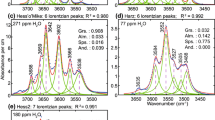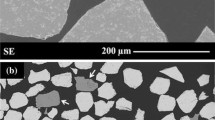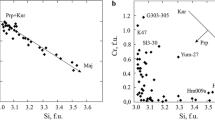Abstract
Samples with eclogitic composition in the system CaO–FeO–Fe2O3–MgO–Al2O3–SiO2 were produced from various kinds of starting materials held in graphite-lined Pt capsules at a pressure of 2.5–3.0 GPa and temperatures of 800–1,300 °C using a piston-cylinder or Belt apparatus. Garnets and clinopyroxenes were characterized by analytical transmission electron microscopy and electron probe micro-analysis (EPMA). Fe3+/ΣFe ratios determined by electron energy-loss spectroscopy (EELS) decrease in clinopyroxene from 22.2 ± 3.4 % at 800 °C to 13.3 ± 5.4 % at 1,300 °C, while in garnet, they vary between 10.8 ± 1.5 and 15.4 ± 4.7 %, respectively. Temperature estimates according to Krogh (Contrib Mineral Petrol 99:44–48, 1988) reproduce the experimental temperature to ±60 °C without systematic deviations if total iron is used in the calculation. If only the Fe2+ content is used, which was obtained by combining EPMA and EELS results, the experimental temperature is underestimated by 33 °C on average at 800–1,200 °C and overestimated by 77 °C on average at 1,300 °C. These systematic deviations can be explained by the temperature-dependent ratio of Fe2+/ΣFe in garnet divided by that in clinopyroxene. Since the difference between the calculated and experimental temperature is relatively small, a Fe2+-based recalibration of the thermometer appears not to be necessary for the investigated system in the range of pressure, temperature and composition covered by the experiments of this study.












Similar content being viewed by others
References
Ai Y (1994) A revision of the garnet–clinopyroxene Fe2+–Mg exchange thermometer. Contrib Mineral Petrol 115:467–473
Banno S (1970) Classification of eclogites in terms of physical conditions of their origin. Phys Earth Planet Interiors 3:405–421
Berman RG, Aranovich LY, Pattison DRM (1995) Reassessment of the garnet–clinopyroxene Fe–Mg exchange thermometer: II. Thermodynamic analysis. Contrib Mineral Petrol 119:30–42
Boyd FR, England JL (1960) Apparatus for phase-equilibrium measurements at pressures up to 50 kilobars and temperatures up to 1750°C. J Geophys Res 65:741–748
Brey GP, Köhler T (1990) Geothermobarometry in four-phase lherzolites II. New thermobarometers, and practical assessment of existing thermobarometers. J Petrol 31:1353–1378
Brey GP, Nickel KG, Kogarko L (1986) Garnet–pyroxene equilibria in the system CaO–MgO–Al2O3–SiO2 (CMAS): prospects for simplified (‘T-independent’) lherzolite barometry and an eclogite-barometer. Contrib Mineral Petrol 92:448–455
Brey GP, Köhler T, Nickel KG (1990a) Geothermobarometry in four-phase lherzolites I. Experimental results from 10 to 60 kb. J Petrol 31:1313–1352
Brey GP, Weber R, Nickel KG (1990b) Calibration of a belt apparatus to 1800°C and 6 GPa. J Geophys Res 95:15603–15610
Canil D, O’Neill HStC (1996) Distribution of ferric iron in some upper-mantle assemblages. J Petrol 37:609–635
Egerton RF (1996) Electron energy-loss spectroscopy in the electron microscope. Plenum, New York
Ellis DJ, Green DH (1979) An experimental study of the effect of Ca upon garnet–clinopyroxene Fe–Mg exchange equilibria. Contrib Mineral Petrol 71:13–22
Falloon TJ, Green DH, Hatton CJ, Harris KL (1988) Anhydrous partial melting of a fertile and depleted peridotite from 2 to 30 kb and application to basalt petrogenesis. J Petrol 29:1257–1282
Ganguly J (1979) Garnet and clinopyroxene solid solutions, and geothermometry based on Fe–Mg distribution coefficient. Geochim Cosmochim Acta 43:1021–1029
Garvie LAJ, Craven AJ, Brydson R (1994) Use of electron-energy loss near-edge fine structure in the study of minerals. Am Mineral 79:411–425
Green TH, Adam J (1991) Assessment of the garnet–clinopyroxene Fe–Mg exchange thermometer using new experimental data. J Metamorph Geol 9:341–347
Köhler TP, Brey GP (1990) Calcium exchange between olivine and clinopyroxene calibrated as a geothermobarometer for natural peridotites from 2 to 60 kb with applications. Geochim Cosmochim Acta 54:2375–2388
Koons PO (1984) Implications to garnet–clinopyroxene geothermometry of non-ideal solid solution in jadeitic pyroxenes. Contrib Mineral Petrol 88:340–347
Krogh EJ (1988) The garnet–clinopyroxene Fe–Mg geothermometer—a reinterpretation of existing experimental data. Contrib Mineral Petrol 99:44–48
Li Y-L, Zheng Y-F, Fu B (2005) Mössbauer spectroscopy of omphacite and garnet pairs from eclogites: application to geothermobarometry. Am Mineral 90:90–100
Luth RW, Canil D (1993) Ferric iron in mantle-derived pyroxenes and a new oxybarometer for the mantle. Contrib Mineral Petrol 113:236–248
Marinenko RB (1982) Preparation and characterization of K-411 and K-412 mineral glasses for microanalysis: SRM 470. Nat Bur Stand (U.S.) Spec Pub 260–274
Nakamura D (2009) A new formulation of garnet–clinopyroxene geothermometer based on accumulation and statistical analysis of a large experimental data set. J Metamorph Geol 27:495–508
Nakamura D, Hirajima T (2005) Experimental evaluation of garnet–clinopyroxene geothermometry as applied to eclogites. Contrib Mineral Petrol 150:581–588
Nimis P, Grütter H (2010) Internally consistent geothermometers for garnet peridotites and pyroxenites. Contrib Mineral Petrol 159:411–427
Pattison DRM, Newton RC (1989) Reversed experimental calibration of the garnet–clinopyroxene Fe–Mg exchange thermometer. Contrib Mineral Petrol 101:87–103
Powell R (1985) Regression diagnostics and robust regression in geothermometer/geobarometer calibration: the garnet–clinopyroxene geothermometer revisited. J Metamorph Geol 3:231–243
Råheim A, Green DH (1974) Experimental determination of the temperature and pressure dependence of the Fe–Mg partition coefficient for coexisting garnet and clinopyroxene. Contrib Mineral Petrol 48:179–203
Ravna EK (2000) The garnet–clinopyroxene Fe2+–Mg geothermometer: an updated calibration. J Metamorph Geol 18:211–219
Ravna EJK, Terry MP (2004) Geothermobarometry of UHP and HP eclogites and shists–an evaluation of equilibria among garnet–clinopyroxene–kyanite–phengite–coesite/quartz. J Metamorph Geol 22:579–592
Saxena SK (1979) Garnet–clinopyroxene geothermometer. Contrib Mineral Petrol 70:229–235
van Aken PA, Liebscher B, Styrsa VJ (1998) Quantitative determination of iron oxidation states in minerals using Fe L2,3-edge electron energy-loss near-edge structure spectroscopy. Phys Chem Minerals 25:323–327
Acknowledgments
Funding by the Deutsche Forschungsgemeinschaft (DFG) is gratefully acknowledged. We would like to thank H. Höfer for helping with the microprobe and M. M. Müller for solving problems in TEM sample preparation. V. Bulatov is thanked for kindly providing some of the synthetic fayalite used for the starting materials. We would like to thank the anonymous reviewer and Robert W. Luth for their constructive reviews.
Author information
Authors and Affiliations
Corresponding author
Additional information
Communicated by M. W. Schmidt.
Electronic supplementary material
Below is the link to the electronic supplementary material.
Rights and permissions
About this article
Cite this article
Purwin, H., Lauterbach, S., Brey, G.P. et al. An experimental study of the Fe oxidation states in garnet and clinopyroxene as a function of temperature in the system CaO–FeO–Fe2O3–MgO–Al2O3–SiO2: implications for garnet–clinopyroxene geothermometry. Contrib Mineral Petrol 165, 623–639 (2013). https://doi.org/10.1007/s00410-012-0827-4
Received:
Accepted:
Published:
Issue Date:
DOI: https://doi.org/10.1007/s00410-012-0827-4




